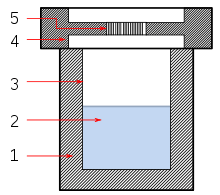Solvothermal synthesis

Solvothermal synthesis is a method of producing chemical compounds. It is very similar to the hydrothermal route (where the synthesis is conducted in a stainless steel autoclave), the only difference being that the precursor solution is usually not aqueous (however, this is not always the case in all literature uses of the expression). Using the solvothermal route gains one the benefits of both the sol-gel[1] and hydrothermal routes.[2] Thus solvothermal synthesis allows for the precise control over the size, shape distribution, and crystallinity of metaloxide nanoparticles or nanostructures. These characteristics can be altered by changing certain experimental parameters, including reaction temperature, reaction time, solvent type, surfactant type, and precursor type.
Solvothermal synthesis has been used in laboratory to make nanostructured titanium dioxide,[3] graphene,[4] carbon[5] and other materials.
The high photocatalytic capacity of TiO2 leads to the degradation of organic [6][7] and biological molecules [8][9] into smaller and less harmful compounds. Because of their small size, TiO2 nanostructures also provide increased surface area at which photocatalytic reactions may occur, increasing their activity. This photocatalytic activity may be applied to air purification,[10] self-sterilization,[11] water purification [12] and molecular hydrogen production.[13] Thus the ability of solvothermal synthesis to precisely tailor TiO2 nanostructures has the potential to maximize the efficiency of those nanostructures in applications.
References
- ↑ Oliveira, Marcela M.; Schnitzler, Danielle C.; Zarbin, Aldo J. G. (2003). "(Ti,Sn)O2Mixed Oxides Nanoparticles Obtained by the Sol−Gel Route". Chemistry of Materials 15 (9): 1903. doi:10.1021/cm0210344.
- ↑ Andersson, Martin; Österlund, Lars; Ljungström, Sten; Palmqvist, Anders (2002). "Preparation of Nanosize Anatase and Rutile TiO2by Hydrothermal Treatment of Microemulsions and Their Activity for Photocatalytic Wet Oxidation of Phenol". The Journal of Physical Chemistry B 106 (41): 10674. doi:10.1021/jp025715y.
- ↑ Xie, Rong-Cai; Shang, Jian Ku (2007). "Morphological control in solvothermal synthesis of titanium oxide". Journal of Materials Science 42 (16): 6583. Bibcode:2007JMatS..42.6583X. doi:10.1007/s10853-007-1506-0.
- ↑ Choucair, Mohammad; Thordarson, Pall; Stride, John A. (2008). "Gram-scale production of graphene based on solvothermal synthesis and sonication". Nature Nanotechnology 4 (1): 30–3. Bibcode:2009NatNa...4...30C. doi:10.1038/nnano.2008.365. PMID 19119279.
- ↑ Hu, Gang; Ma, Ding; Cheng, Mojie; Liu, Lin; Bao, Xinhe (2002). "Direct synthesis of uniform hollow carbon spheres by a self-assembly template approachElectronic supplementary information (ESI) available: SEM pictures of the products from simple mixing. See http://www.rsc.org/suppdata/cc/b2/b205723a/". Chemical Communications (17): 1948. doi:10.1039/B205723A.
- ↑ Kongsuebchart, W; Praserthdam, P; Panpranot, J; Sirisuk, A; Supphasrirongjaroen, P; Satayaprasert, C (2006). "Effect of crystallite size on the surface defect of nano-TiO2 prepared via solvothermal synthesis". Journal of Crystal Growth 297: 234. Bibcode:2006JCrGr.297..234K. doi:10.1016/j.jcrysgro.2006.09.018.
- ↑ Kus, Mahmut; Gernjak, Wolfgang; Ibáñez, Pilar FernáNdez; Rodríguez, Sixto Malato; Gálvez, Julián Blanco; Icli, Siddik (2006). "A Comparative Study of Supported TiO[sub 2] as Photocatalyst in Water Decontamination at Solar Pilot Plant Scale". Journal of Solar Energy Engineering 128 (3): 331. doi:10.1115/1.2210494.
- ↑ Cheng, Y.W.; Chan, Raphael C.Y.; Wong, P.K. (2007). "Disinfection of Legionella pneumophila by photocatalytic oxidation". Water Research 41 (4): 842–52. doi:10.1016/j.watres.2006.11.033. PMID 17224169.
- ↑ Amezagamadrid, P; Silveyramorales, R; Cordobafierro, L; Nevarezmoorillon, G; Mikiyoshida, M; Orrantiaborunda, E; Solis, F (2003). "TEM evidence of ultrastructural alteration on Pseudomonas aeruginosa by photocatalytic TiO2 thin films". Journal of Photochemistry and Photobiology B: Biology 70: 45. doi:10.1016/S1011-1344(03)00054-X.
- ↑ Josset, S; Taranto, J; Keller, N; Keller, V; Lett, M; Ledoux, M; Bonnet, V; Rougeau, S (2007). "UV-A photocatalytic treatment of high flow rate air contaminated with Legionella pneumophila". Catalysis Today 129: 215. doi:10.1016/j.cattod.2007.08.010.
- ↑ Mitoraj, Dariusz; Ja?czyk, Agnieszka; Strus, Magdalena; Kisch, Horst; Stochel, Gra?yna; Heczko, Piotr B.; Macyk, Wojciech (2007). "Visible light inactivation of bacteria and fungi by modified titanium dioxide". Photochemical & Photobiological Sciences 6 (6): 642–8. doi:10.1039/B617043A. PMID 17549266.
- ↑ Yurdakal, S; Loddo, V; Augugliaro, V; Berber, H; Palmisano, G; Palmisano, L (2007). "Photodegradation of pharmaceutical drugs in aqueous TiO2 suspensions: Mechanism and kinetics". Catalysis Today 129: 9. doi:10.1016/j.cattod.2007.06.044.
- ↑ Park, H.; Vecitis, C.D.; Choi, W.; Weres, O.; Hoffmann, M.R. (2008). "Solar-Powered Production of Molecular Hydrogen from Water". Journal of Physical Chemistry C 112 (4): 885. doi:10.1021/jp710723p.